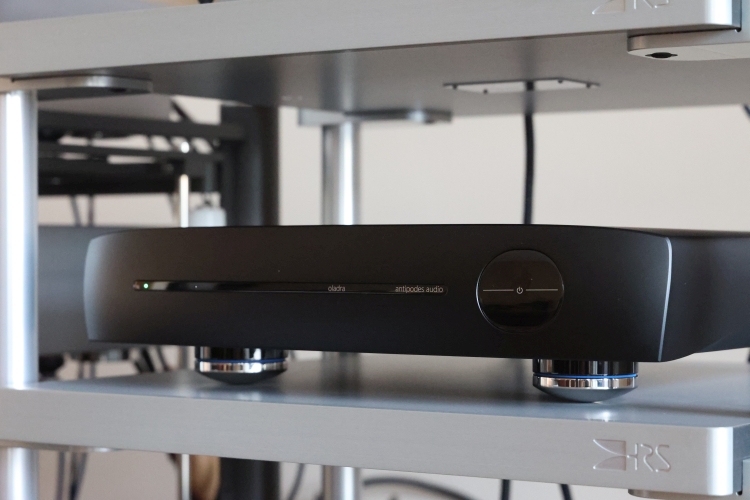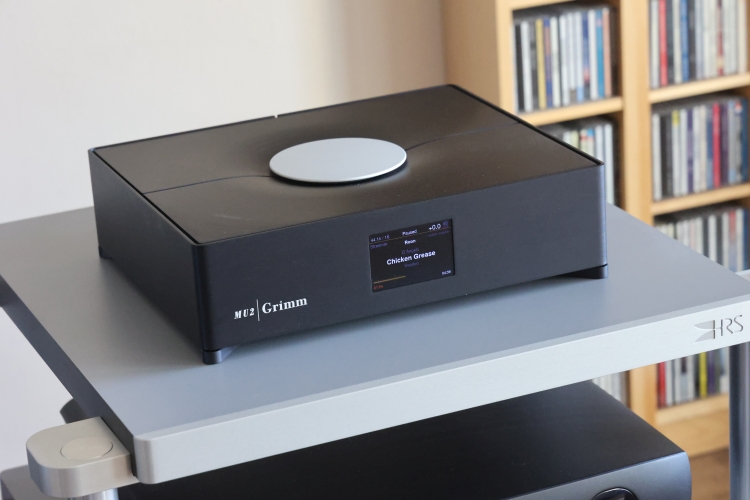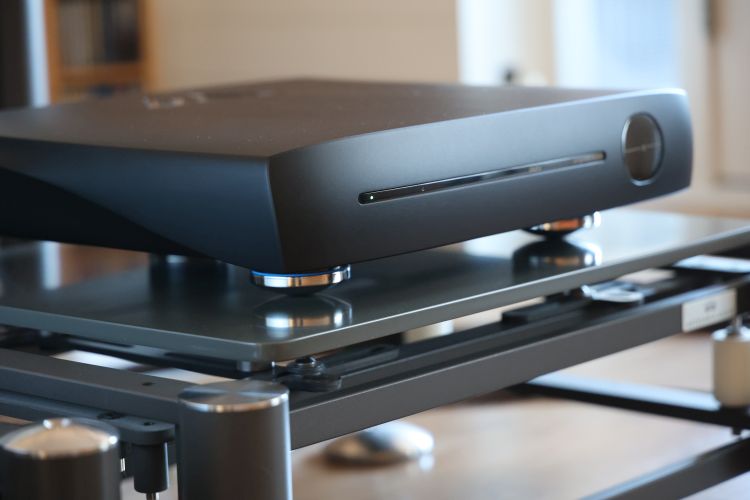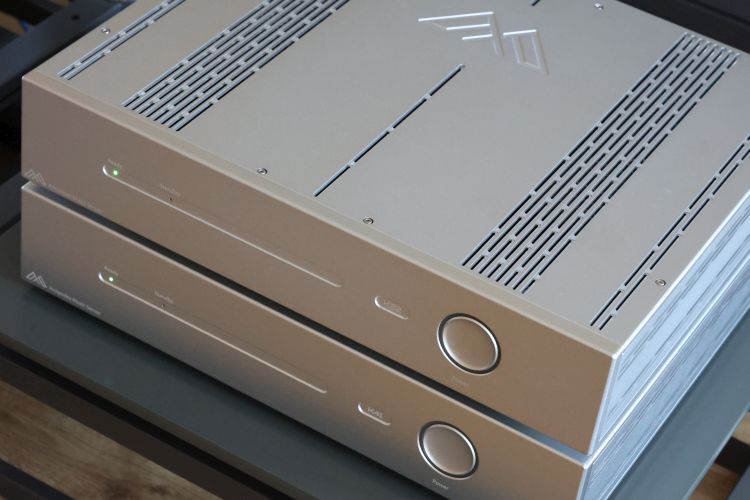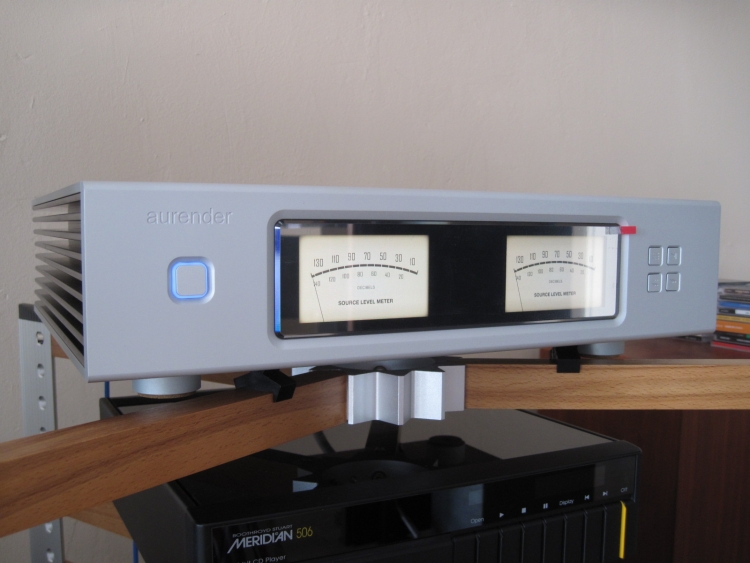
High End integrated Storage and Music Playback System without DAC
Here’s a convenient and neat all in one solution. Can we finally banish the PC, monitor and associated mess from the living room and tuck out the CD player?
Review sample supplied by Studio Alkmaar, retailer in the Netherlands.
Retail price 5990 euro
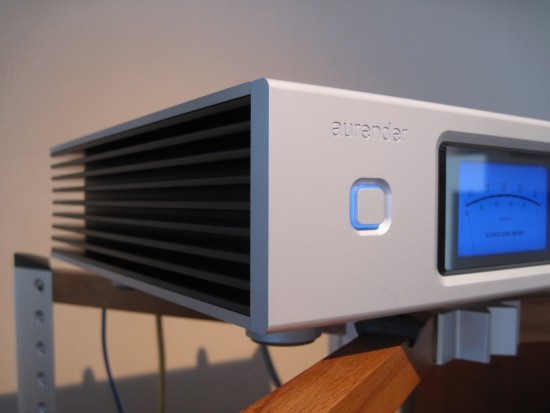
First Contact
When I first laid eyes on the Aurender at an audioshow a year or so ago, I was immediately drawn to it. I guess it was in the eyes: much like the famous McIntosh blue meters, the Aurender’s multi-purpose displays can have a mesmerizing effect on people. Naturally there’s more to a product than its displays but the Aurender continues to impress with its all-around beautifully crafted, thick aluminum casing, its precisely inlaid connectors at the rear side and its staggering weight. There is no doubt: this is a serious product.
I’ve been trying to get my hands on a review sample ever since but didn’t succeed until I saw it at one of my favorite audio stores, Studio Alkmaar. Ben Hoedjes, the owner, was more than happy to lend it to me for review. And so it happens that I am now in the interesting position to compare it to not only its direct competitor in this price range, the PS Audio PWD MKII, but also to what I consider to be the best in streaming audio, the Meridian 818.
The Aurender S10 is an integrated music server: it has a 2TB built-in hard disk, and as such, it works without the addition of a NAS or computer acting as a server. What isn’t inside however is a DAC. It isn’t simply a computer with slapped-on soundcard but a completely customized solution. Inside the Aurender S10 resembles the way that big Wadias are built, with three separate sections separated by thick aluminum walls. At its base is a computer motherboard, running custom Linux software and the board is housed in its own section at the bottom of the unit. Power for the motherboard comes from a switched unit which is tucked away in the basement too. There’s also one of the linear kind (not switching) that feeds the soundcard, and it, too, has its own compartment. Then there’s the sound card. This is where it gets really special because parent company Widealab decided that no standard soundcard was good enough for their purpose, so they built their own. And a beauty it is, using custom Widealab OCXO (Oven Controlled Crystal Oscillators) clock and re-clocking modules. Accurate clocking is very important, especially when different kinds of sample rates are to be used. And of course it is never beneficiary to run a signal over sp/dif so the better the clock is, the better the retrieved signal at the other end of the cable is. The coax, AES/EBU and optical outputs are fed by the custom soundcard. It is also possible to connect the Aurender via USB. That way the signal will bypass the soundcard and the receiving unit will take over the clocking duties.
The Aurender works differently from usual servers in that it employs a regular 2TB hard disk in combination with an SSD drive. The 2TB disk contains the music files and they are read in solid state memory for playback. This has several advantages. First: startup time is minimized, even when the hard disk is in sleep mode, the files in the play cue start right away. Second: there is absolutely no noise emanating from the enclosure. Not that the regular disk is noisy though: even with it running you can hardly hear it. A soft whirr is all you’ll ever hear, and even when standing within 2 meters of distance. By comparison, the Meridian MD600 is incredibly noisy. The third benefit of playback from solid-state memory is in the sound quality. Oh, and even the motherboard is convection-cooled: no fans.
Operational control is limited to the iPad app called Aurender Conductor, and prev/fwd/play/pause buttons on the front panel. There’s no provision for IR remote control. I would personally like to see menu control from the frontpanel as well as IR remote control of at least the playlist, but the way that control is carried out via iPad really is something else. Meridian take note: the database is actually stored on the iPad itself, providing blazing-fast access to all data. For this to work, you’ll only need to update the information after adding new music to the Aurender’s hard disk, but that’s an easy and quick task and it requires only that you either wait for a couple of minutes and it will be done automatically, or, if you’re the impatient kind (like me), you can go into the options on the iPad and select manual update. This takes less than a minute. Because the information and artwork is stored on the iPad itself, browsing is a lot quicker than with competing products. Even Meridian with its very swift Sooloos system is a little slower, especially when browsing album covers on the iPad.
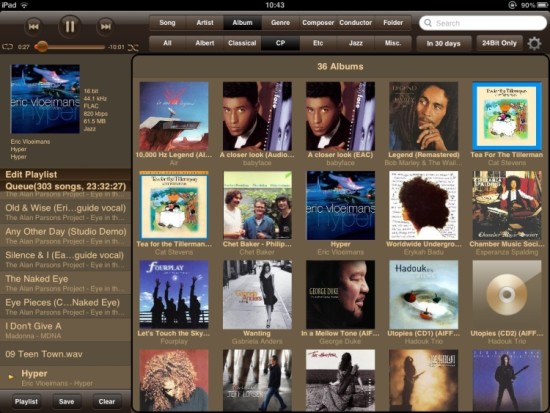
Incidentally, when using the Aurender’s built in drive for playback on a network-connected computer, access times are also very fast: even with the disk spun down, music will play within a few seconds. On that note: unlike Meridian’s Sooloos system, the Aurender sports an open architecture. You can freely copy files to it and back using a networked computer or a USB-connected USB stick, diskdrive or CD ROM drive. Importing music is as simple as drag and drop. The Aurender will play all popular audio formats natively and it doesn’t alter the files or their attributes in any way. All it does is to index them and send the database to the iPad. You’re free to use any naming conventions or directory structure that you like. The Aurender will search for metadata in tags and will categorize accordingly. Unlike with Meridian, this does work flawlessly, even for incomplete albums or single tracks. (Sooloos only works accurately when importing entire CD’s) What’s more: beside the regular tags such as artist, album and track etc, there is a second row of filters in the iPad app which lets you select the folders that you created in the root directly. This way you are entirely free to browse custom selections by folder and still be able to filter by tags. Naturally there’s also a smart search function that works quickly (remember: the database is stored on the iPad) and reliably.
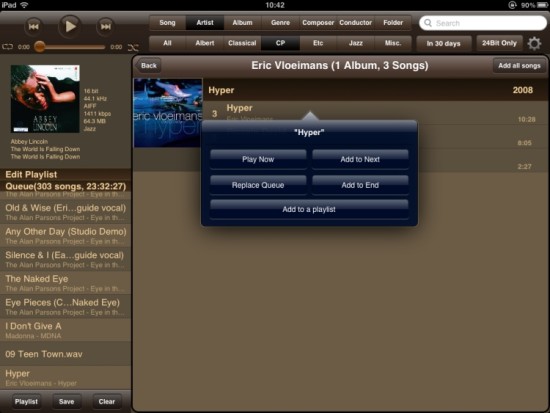
Another area in which the Aurender iPad app excels is in playlist functionality. In a way it combines the best of Meridian and PS Audio. It has Meridian’s short access times and quick browsing but also offers PS Audio PWD’s extended playlist options, and more. For example while you can make a playlist and store it with Meridian, you can only do this from the currently playing section. So, in order to make a list, you’ll have to load your selection track by track, then save it to a playlist. If you are just playing music, then hear something you like and want to add to an existing playlist, you’ll have to stop playback, load the playlist that you want to save to, find the track again, add it to the list and save again. With Aurender you can simply save a track to a new or existing playlist from any location, even without interrupting the currently playing music.
When adding a song to the playlist, you have the option to play now, add next or add to end. These are fairly common functions that Meridian, Linn and PS Audio also offer. But once again there something extra: for example, when adding the track to the end of the current playlist, the list briefly scrolls down, highlights the track you just added and scrolls back to the currently playing track. That’s just exactly the way that you’d want it to work. Additionally, you can also choose to replace the current cue with your new selection. Nicely done.
There are more than 20 viewing variations and shown are only a few of them.
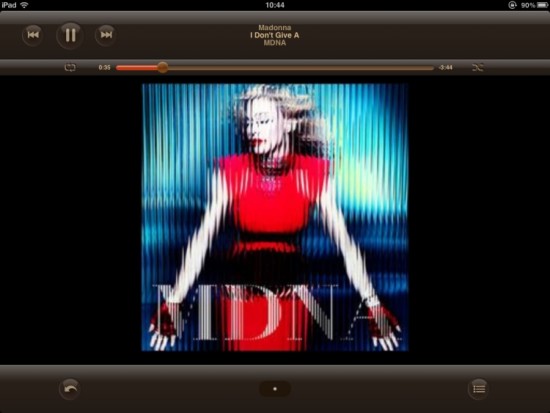
In the header, I already mentioned the front panel displays. These are actually OLED displays with high resolution and an extremely wide viewing angle. You can toggle between modes from the front panel or the iPad app. The modes include level meters in (McIntosh-like-) blue, (Accuphase-like-) yellow and plain text information. The information on offer is very complete, including artist, title, progress bar, elapsed time, remaining time, sample rate, bitrate and file format. Again, very nice.
Setup is a snap. Network connections work quickly and reliably. The iPad finds the Aurender automatically and after entering the code that appears on the Aurender’s display, the two seem mated for life because they didn’t lose connection, not once!
I could go on and on about the functionality but that would take up a lot more space and probably bore the hell out of more than a few readers. Also, there’s more than enough info to be found on this elsewhere on the web, for example on the excellent Computer Audiophile site. I’ll leave it at this and proceed to the matter of sound quality.
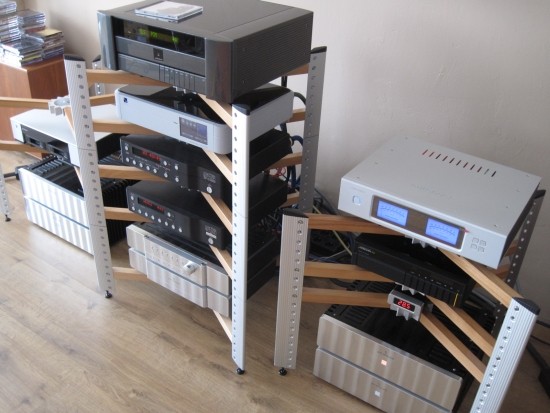
Comparisons
Compared to a Windows computer with HiFace EVO and Levinson 360S DAC
First, let’s compare the Aurender’s sound to that of my main Windows computer. The Aurender is connected to the Mark Levinson no.360S DAC with a Wireworld Gold Starlight III+ coaxial digital cable. The Windows computer plays back the exact same files, straight from the Aurender’s internal disk. I use Winamp 5 with kernel streaming into an external USB-Spdif converter in the shape of the M2Tech HiFace EVO. From there the signal runs over ST glass into the same Levinson 360S DAC. Should be a pretty fair comparison.
The difference is obvious: while the computer sounds very nice: full and smooth, in comparison to the Aurender directly into the DAC the computer also sounds blurry and lacking PRAT and dynamic differentiation. The Aurender is crispier but without becoming hard, shouty or edgy. Its treble is very pure, open, airy, precise, but also fluid. Its bass is arguably less full than that from the computer but that’s likely a subjective matter resulting from its less focused nature, making the bass seem fuller. And indeed, the Aurender goes just as deep but is just more upbeat and articulate. Also, the Aurender has better focus and imaging between the speakers, and acoustical sounds are more wooden, more visceral, and real. The computer may be more forgiving, but the Aurender is more real. Mind you, this is without any further comparisons to the Levinson or Meridian CD players, PS Audio PWD MKII or Meridian 818.
To be sure, I also compared Windows playback of the same file from its built-in hard disk instead of “streaming” over the network connection from the Aurender. There was a difference, but it was slight. When playing from its built-in drive, the computer sounded a little more relaxed and less pinched in the midrange. Otherwise, the difference was small. In any case, this didn’t turn the computer into an Aurender.
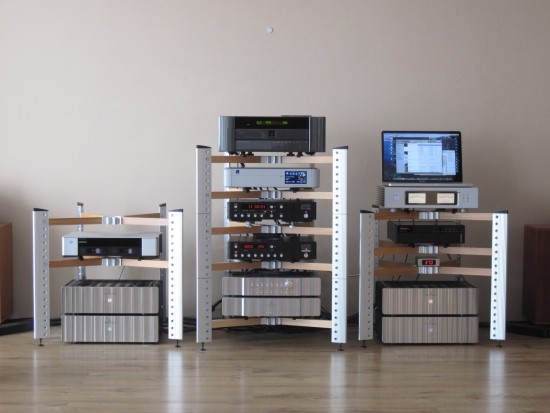
Compared to Meridian 818 (Sooloos)
Playing the same tracks on the Meridian 818 in Sooloos mode after import to the Meridian Media Drive 600 reveals that while the Aurender-Levinson combo played very nice and better than the Computer, the Meridian combo sounds much better in almost every aspect. Most importantly, there’s a much larger soundstage with better layering and pinpointing, and the image really comes free from the speakers, while with the Aurender-Levinson combo, the image is comparably flat and less engaging. So, perhaps the Aurender-Levinson combo wasn’t the best possible match?
Changing the Levinson for the PWD MKII
With the Aurender playing into the PS Audio PWD MKII’s coaxial input, the game changes. There’s a more confident sound with a larger stage and more involvement. Tonality is much better than through the Levinson. Now, I’m starting to like the Aurender. But I’m still missing some involvement and depth of staging.
Changing the PWD MKII for the Meridian 818 (DAC)
The Meridian 818 isn’t only a Sooloos endzone: it is also a fully-fledged DAC. With the Aurender playing into its coaxial digital input the game really changes. Now I am hearing the big soundstage that the Meridian combo is capable of, but sourced from the Aurender. This is a nicely open and fluid sound and it is engaging. But when switching back to the Meridian-Meridian combo in Sooloos mode, it becomes clear that there is still a perceived difference between shall we say “real music” and “computer-derived music”. Even now that the Aurender presents the music in a wide stage, with excellent PRAT, midband openness and treble liquidity, the Sooloos combo remains more engaging. This isn’t a matter of detail or openness, but something that’s difficult to describe. It’s akin to real acoustical instruments versus digitally sampled instruments. The first just seems more real, even if the latter can appear to be more precise.
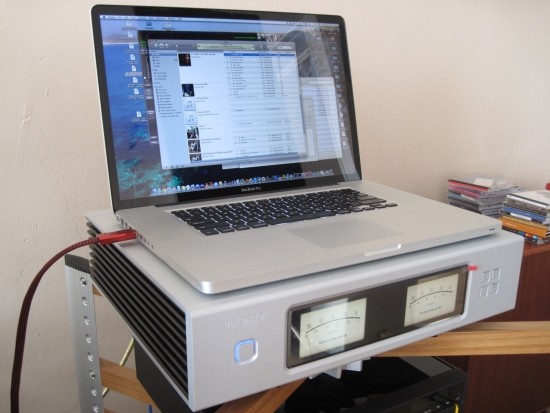
Going USB
The Aurender also offers USB playback into any USB DAC. This bypasses the soundcard with its special OCXO clock and derives the signal straight from the motherboard. Connecting the Aurender with a KingRex Unanimous uART USB cable to the PS Audio PWD makes for an unexpected leap in performance! Now, there was the soundstaging layering I was looking for. With it, excitement, bass heft, intimacy and treble fluidity and airiness. Going back and forth between spdif and USB yielded consistent results, USB sounding much more involving and real, spdif sounding artificial by comparison.
Just to be sure that I wasn’t only appreciating the PWD’s admittedly excellent USB capabilities, I also connected the Macbook with the same cable and played the same files in iTunes using PureMusic. Yes, soundstaging is similar, but the Aurender consistently sounds more acoustical, more dynamic and more precise. The Macbook is a smidgeon airier, but compared to the Aurender, it sounds more electronic because of it, the Aurender being more real, more believable.
Compared to the PWD MKII in streaming mode
You’d almost forget that the PWD is also a superb streamer, but since I’m comparing everything with everything, I also listened to the PWD in streaming mode using a Synology NAS. The resulting sound is comparable to that when using the Aurender via USB, but slightly darker and with slightly fuller bass. It seems that the Aurender compensates for the PWD’s inherent treble darkness and slight grain. But the difference isn’t big enough to matter very much. Either solution sounds fantastic and it would be up to the music played whether one or the other would be a better match. I’d say it is a tie. And that’s saying something! Kudos to the Aurender.
Listening to the Levinson CD player
As a quick reference, I also listened to the Levinson 390S CD player. Soundwise, it is much like the Meridian 818-MD600 combo: musical, fluid, and involving. However, it doesn’t have the Meridian’s huge soundstaging or low-level detailing. Also, it doesn’t have the Aurender’s sublime PRAT and dynamics when combined with the PWD MKII via USB. Still, the CD is nice, being a little smoother and more forgiving.
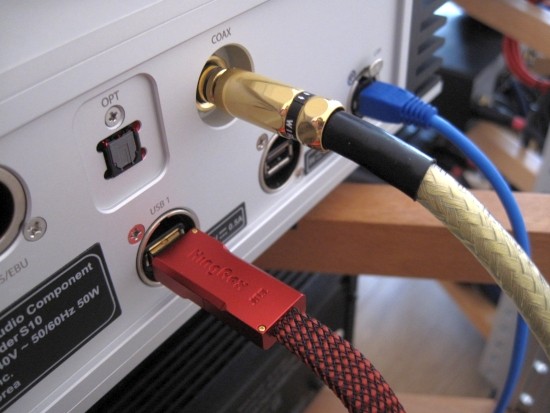
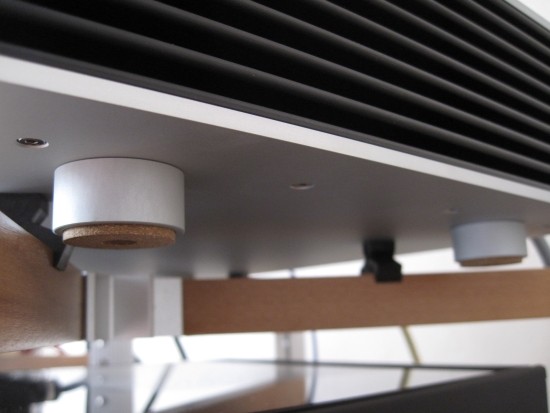
Conclusion
The CD player aside and concentrating on the streamers at hand, I had a hard time choosing between the Aurender-USB-PWD MKII combo and the Meridian Sooloos combo. The former is more lively and more dynamic, with real slam, power and excitement. It sounds much like a Wadia and it is a familiar sound, one that I like a lot. The latter is more forgiving in nature. Treble is smoother and more gentle, midrange is richer and less shouty and the bass a little thinner, but more nimble and agile. Lastly, the latter combo manages to create an even bigger, more intimate soundfield. I can understand how one well-known English hifi magazine came to the conclusion that Meridian Sooloos sounded slightly rounded or soft. But the same is true of my Levinsons and many other CD players. With many CD’s, having a forgiving CD player is no bad thing. Nevertheless, there is a lot to say for the Aurender sounding more accurate. But I’m not hearing any more detail with the Aurender than with the Meridians. It’s more about Meridian being more continuous versus the Aurender being more start-stop.
Although I am biased towards the Meridian because of its gentle, full, fluid, always engaging sound, I also enjoyed the heck out of the Aurender-PWD MKII combo. If money was no object then I’d probably keep the Aurender around as an alternative to the Sooloos combo. It seems silly to combine the 6000 euro Aurender with the 5200 euro PWD MKII and not even use the latter’s streaming capabilities. But together, this is still less than the Meridian combo costs, and it adds so much flexibility that I could almost recommend them as natural partners. Don’t forget that the Aurender offers tremendously user-friendly operation, rivaling Sooloos and bettering it in a couple of aspects. This is something that cannot be achieved with a home-made server, not to mention that it probably wouldn’t sound as good either.
But I’m sure there will be other USB DACs that are a good match. The Ayre QB9 for example would likely make for a superbly detailed and open sound. But there are so many USB DACs around and you’re bound to find a really good one at under 2500-3000 euro. If you manage to find one that sounds as good as the PWD MKII, then you have a winning combination that challenges the best that Sooloos has to offer for considerably less money.
Now, considering that spdif always seems to take its toll, I’d advocate trying to avoid it if you can and use USB instead, as long as the DAC has a good USB implementation. This makes me think… if only the Aurender was available in a USB-only version, without the presumably expensive soundcard, and 1000 euro off, then it would be even more irresistible! Hang on – something similar already exists, in the shape of the Aurender A10. It has similar specs but no oven-controlled clock. I’d be curious to find out if it performs just as well as the S10 with USB. For now, the S10 is the best integrated server that I have come across.
Update November 2015
Meanwhile, I have changed components, setups and setup positions, and have listened to many music servers. Recently the S10 was part of my setup again because a friend brought it along. A full report stretches too far for this addendum, but it is important to note that I feel that the S10 still performs very well.
Especially noteworthy is its performance using its spdif outputs. When I wrote the initial review, I found they sounded more “technical” than the USB output. This time around I’m not so sure anymore. As I already found using the Jeff Rowland Aeris DAC, using spdif isn’t necessarily always a limiting factor. What’s more: using the EC Designs Mosaic NOS DAC connected (via Toslink no less), the Aurender S10 really sounds stellar.
Once again, things in audio turn out to be relative.
Now, can you guess what I am curious about? Did someone say N10?

S10 – Matters to consider
NAS playback
According to the manual the Aurender also plays ball with an external NAS, but I couldn’t get this to work. I can see my Synology but cannot browse its contents. On that note: I read that while it should work, even if it does, there isn’t the advantage of the iPad database. Apparently you can only browse on file structure level. But that really doesn’t matter as far as I’m concerned. The built in drive is large enough not to pose a limit to many music lovers. Also I think that the development hasn’t stopped, and with the Aurender being what it is, theoretically it can always be updated to add functionality.
Auto-copy files from USB stick or auto-ripping CD ROM drive
Although the manual mentions that this will work, one needs to be sure that all files are properly tagged and that a connection to the internet is available, otherwise wrong info may come up. There is no way to check the progress and changes can only be made after the import process, from a networked computer. It is, therefore, preferable to do the ripping and tagging beforehand on a computer (Windows or Mac) and copy the files directly from that computer. That way you also have control over merging artists and such.
OLED Displays
The displays have excellent resolution and an enormously wide viewing angle, and the fact that you can choose between text info and two meter styles is awesome but the way that the “VU meter” animation is implemented needs some work. For one the response time is very slow and the framerate seemingly low too. Second the needle moves in such a manner that would physically only be possible if its pivot would be half a meter below the unit. Naturally this doesn’t matter for the music and it really is a moot point. But for me it detracts from an otherwise fantastic product. The fact that it could potentially easily be remedied by a software update made me decide to post this matter anyway.




